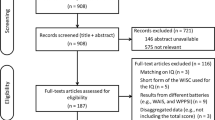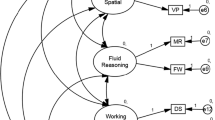Abstract
This chapter describes investigations of gender differences in cognitive abilities and their relations to performance on standardized achievement tests in grade 6. The data used come from Jan-Eric Gustafsson’s projects in the 1980s where cognitive achievement on a battery of 13 different ability tests and 3 different standardised achievement tests were collected from 50 school classes. The nested factor (NF) approach demonstrated by Gustafsson (Multivar Behav Res 27(2):239–247, 1992) and the missing data modeling approach suggested by Muthén et al. (Psychometrika 52:431–462, 1987) were used to investigate gender differences in latent dimensions of hierarchically ordered cognitive abilities. Based on the results, it is argued that a more complex understanding is needed of the measures, as well as of the observed performances, of the compared groups. Whilst the modeled hierarchical structure of cognitive abilities fitted both groups equally well, the pattern of mean differences in latent dimensions showed both expected and unexpected results. A female advantage was found on general intelligence (g) and on the broad general crystallised intelligence factor (Gc). A male advantage was found on the general visualization factor (Gv), and on several narrow ability dimensions. This was not deducible from the univariate analysis. The chapter ends with a discussion on the degree to which these differences fit the assumptions of the so-called investment theory, that general fluid intelligence (Gf) precedes other broad abilities and narrow ability dimensions.
Access this chapter
Tax calculation will be finalised at checkout
Purchases are for personal use only
Similar content being viewed by others
References
Anastasi, A. (1958). Differential psychology. New York: MacMillan.
Carlstedt, B. (1997). Test complexity and measurement of the general factor. Manuscript submitted for publication.
Carroll, J. B. (1993). Human cognitive abilities: A survey of factor-analytic studies. Cambridge: Cambridge University Press.
Cattell, R. B. (1943). The measurement of adult intelligence. Psychological Bulletin, 40, 153–193.
Cattell, R. B. (1971). Abilities: Their structure, growth and action. Oxford, England: Houghton Mifflin.
Cattell, R. B. (1987). Intelligence: Its structure, growth and action. Amsterdam: Elsevier Science Publishers.
Cleary, A. T. (1992). Gender differences in aptitude and achievement test scores. In J. Pfleiderer (Ed.), Sex equity in educational opportunity, achievement and testing. Proceedings of the 1991 ETS Inivitational Conference (pp. 51–90). Princeton, NJ: Educational Testing Service.
Cliffordson, C.,& Gustafsson, J.-E. (2008). Effects of age and schooling on intellectual performance: Estimates obtained from analysis of continuous variation in age and length of schooling. Intelligence, 18(1), 143–152.
Coyle, T. R., Snyder, A. C., & Richmond, M. C. (2015). Sex differences in ability tilt: Support for investment theory. Intelligence, 50, 209–220.
Dickens, W. T., & Flynn, J. R. (2001). Heritability estimates versus large environmental effects: The IQ paradox resolved. Psychological review, 108(2), 346.
Emanuelsson, I., & Fischbein, S. (1986). Vive la difference? A study of sex and schooling. Scandinavian Journal of Educational Research, 30,, 71–84.
Entwisle, D. R., Alexander, K. L., & Olson, L. S. (1997). Children, schools & inequality. Oxford: Westview Press.
Feingold, A. (1988). Cognitive gender differences are disappearing. American Psychologist, 43(2), 95–103.
Gustafsson, J.-E. (1984). A unifying model for the structure of intellectual abilities. Intelligence, 8, 179–203.
Gustafsson, J.-E. (1988). Hierarchical models of individual differences in cognitive abilities. In R. J. Sternberg (Ed.), Advances in the psychology of human intelligence (Vol. 4, pp. 35–71). Hillsdale, New Jersey: Lawrence Erlbaum Associates, Inc.
Gustafsson, J.-E. (1992). The relevance of factor analysis for the study of group differences. Multivariate Behavioral Research, 27(2), 239–247
Gustafsson, J.-E. (1994). Hierarchical models of intelligence and educational achievement. In A. Demetriou & A. Efklides (Eds.), Intelligence, mind and reasoning: Structure and development. Amsterdam: Elsevier.
Gustafsson, J.-E. (1997). Measuring and understanding G: Experimental and correlational approaches. Paper presented at the conference “The Future of Learning and Individual Differences research: Processes, Traits and Content”, University of Minnesota, October 9–12.
Gustafsson, J.-E., & Balke, G. (1993). General and specific abilities as predictors of school achievement. Multivariate Behavioral Research, 28(4), 407–434.
Gustafsson, J.-E., Lindström, B., & Björck-Åkesson, E. (1981). A general model for the organization of cognitive abilities (Report 1981:06). Göteborg, Sweden: Göteborg University, Department of Education and Educational Research.
Gustafsson, J.-E., & Stahl, P. A. (1997). STREAMS User’s Guide, Version 1.7. Mölndal, Sweden: MultivariateWare.
Gustafsson, J.-E., & Undheim, J. O. (1992). Stability and change in broad and narrow factors of intelligence from ages 12 to 15 years. Journal of Educational Psychology, 84(2), 141–149.
Gustafsson, J.-E., & Undheim, J. O. (1996). Individual differences in cognitive functions. In D. Berliner & R. Calfee (Eds.), Handbook of educational psychology (pp. 186–242). New York: Macmillan.
Härnqvist, K. (1997). Gender and grade differences in latent ability variables. Scandinavian Journal of Psychology, 38(1), 55–62.
Hollingworth, L. S. (1914). Variability as related to sex differences in achievement. A critique. The American Journal of Sociology, 19, 510–530.
Horn, J. L., & Cattell, R. B. (1966). Refinement and test of the theory of fluid and crystallized intelligence. Journal of Educational Psychology, 57, 253–270.
Hyde, J. S., & Linn, M. C. (1988). Gender differences in verbal ability: A meta-analysis. Psychological Bulletin, 194(1), 53–69.
Jöreskog, K. G., & Sörbom, D. (1993). LISREL 8: User’s Reference Guide (2nd ed.). Chicago: Scientific Software.
Klauer, J. K., & Phye, G. D. (2008). Inductive reasoning: A training approach. Review of Educational Research, 78(1), 85–123.
Kyllonen, P. C., & Christal, R. E. (1990). Reasoning ability is (a little more than) working-memory capacity. Intelligence, 14(4), 389–433.
Landauer, T. K., & Dumais, S. T. (1997). A solution to Plato’s problem: The latent semantic analysis theory of acquisition, induction, and representation of knowledge. Psychological Review, 104(2), 211.
Ljung, B.-O. (1965). The adolescent spurt in mental growth. Acta Universitatis Stockholmiensis. Stockholm Studies in Educational Psychology 8. Stockholm: Almqvist & Wiksell.
Lohman, D. (2004). Aptitude for college: The importance of reasoning tests for minority admissions. In R. Zwick (Ed.), Rethinking the SAT. The future of standardized testing in university admissions (pp. 41–56). New York and London: Routledge Falmer.
Lohman, D. F., & Lakin, J. M. (2011). Intelligence and reasoning. In R. J. Sternberg & S. B. Kaufman (Eds.), The Cambridge handbook of intelligence (pp. 419–441). New York, NY: Cambridge University Press.
Maccoby, E. D., & Jacklin, C. (1974). The psychology of sex differences. Stanford, California: Stanford University Press.
Muthén, B., Kaplan, D., & Hollis, M. (1987). On structural equation modelling with data that are not missing completely at random. Psychometrika, 52, 431–462.
Muthén, B. O., & Muthén, L. (1998–2015). Mplus User’s Guide. Seventh Edition Los Angeles, CA: Muthén and Muthén.
Olsson, E. (2016). On the impact of extramural English and CLIL on productive vocabulary. Diss. Gothenburg : Acta Universitatatis Gothoburgensis.
Reuterberg, S. E. (1997). Gender differences on the Swedish scholastic aptitude test (Report no 1997:02). Gothenburg: University of Gothenburg, Department of Education.
Reuterberg, S. E. (1998). On differential selection in the Swedish scholastic aptitude test. Scandinavian Journal of Educational Research, 42(1), 81–97.
Rindermann, H., Flores-Mendoza, C., & Mansur-Alves, M. (2010). Reciprocal effects between fluid and crystallized intelligence and their dependence on parents’ socioeconomic status and education. Learning and Individual Differences, 20(5), 544–548.
Rosén, M. (1995). Gender differences in structure, means and variances of hierarchically ordered ability dimensions. Learning and Instruction, 5, 37–62.
Rosén, M. (1998a). Gender differences in hierarchically ordered ability dimensions. The impact of missing data. Structural Equation Modeling, 5(1), 37–62.
Rosén, M. (1998b). Gender differences in patterns of knowledge. Göteborg studies in educational sciences 124. Göteborg, Sweden: Acta Universitatis Gothoburgensis.
Spearman, C. (1923). The nature of ‘intelligence’ and the principles of cognition. London: MacMillan.
Spearman, C. (1927). The abilities of man. London: MacMillan.
Spearman, C. (1904). “General Intelligence,” objectively determined and measured. The American Journal of Psychology, 15(2), 201–292.
SPSS. (1998). Base. SPSS 8.0 for Windows User’s Guide. Chicago: SPSS.
Sylvén, L. K., & Sundqvist, P. (2012). Gaming as extramural English L2 learning and L2 proficiency among young learners. ReCALL, 24(03), 302–321.
Thurstone, L. L. (1938). Primary mental abilities. Psychometric Monographs, No 1.
Undheim, J. O. (1981). On intelligence II: A neo-Spearman model to replace Cattell’s theory of fluid and crystallized intelligence. Scandinavian Journal of Psychology, 22, 181–187.
Undheim, J. O., & Gustafsson, J.-E. (1987). The hierarchical organization of cognitive abilities: Restoring general intelligence through the use of linear structural relations (LISREL). Multivariate Behavioural Research, 22, 149–171.
Valentin Kvist, A., & Gustafsson, J.-E. (2008). The relation between fluid intelligence and the general factor as a function of cultural background: A test of Cattell’s investment theory. Intelligence, 36(5), 422–436.
Walsh, M. R. (1987). The psychology of women: Ongoing debates. New Haven: Yale University Press.
Wernersson, I. (1989). Olika kön samma skola? En kunskapsöversikt om hur elevernas könstillhörighet påverkar deras skolsituation [Different gender same school? A research review of how the students gender affect their school situation]. Skolöverstyrelsen, Vad säger forskningen F 89:1.
Willingham, W. W., & Cole, N. S. (1997). Gender and fair assessment. Mahwah, NJ: Lawrence Erlbaum Associates.
Author information
Authors and Affiliations
Corresponding author
Editor information
Editors and Affiliations
Rights and permissions
Copyright information
© 2017 Springer International Publishing AG
About this chapter
Cite this chapter
Rosén, M. (2017). Gender Differences in Broad and Narrow Ability Dimensions. In: Rosén, M., Yang Hansen, K., Wolff, U. (eds) Cognitive Abilities and Educational Outcomes. Methodology of Educational Measurement and Assessment. Springer, Cham. https://doi.org/10.1007/978-3-319-43473-5_4
Download citation
DOI: https://doi.org/10.1007/978-3-319-43473-5_4
Published:
Publisher Name: Springer, Cham
Print ISBN: 978-3-319-43472-8
Online ISBN: 978-3-319-43473-5
eBook Packages: EducationEducation (R0)




